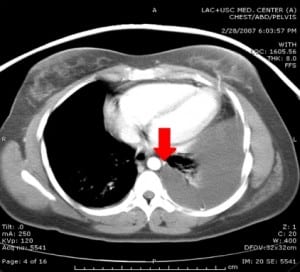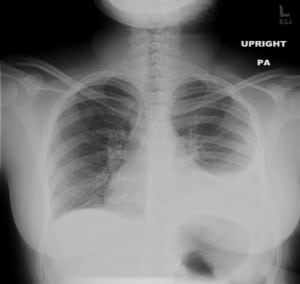| Author | Affiliation |
|---|---|
| Nicholas Testa, MD | Department of Emergency Medicine, Keck School of Medicine of the University of Southern California Medical Center |
| Sean O. Henderson, MD | Department of Emergency Medicine, Keck School of Medicine of the University of Southern California Medical Center |
A 30-year-old African-American female presented to the Emergency Department with a complaint of a cough for two months. The patient had a history of developmental delay, seizure disorder and ventriculo-peritoneal (VP) shunt. Physical exam was significant for a blood pressure at 101/71 mm Hg, heart rate at 111 beats per minute, respiratory rate at 18 breaths per minute and temperature of 98° F. She was a well-developed female in no apparent distress with a shunt palpable on the left side of the skull and a normal lung exam, except for slightly decreased breath sounds in the left base. During her workup, a chest x-ray demonstrated a large left-sided pleural effusion (Figure 1). The patient received a thoracentesis and the fluid was initially thought to be a transudate.
Subsequent CT scan of the chest revealed the tip of the VP shunt in the left chest adjacent to the aorta resulting in a CSF hydrothorax (Figure 2). Thoracic migration of peritoneal catheters causing hydrothorax is a rare complication of VP shunts.1 In some cases the migration of the catheter results in malfunction and neurologic findings, which was not the case in our patient.2

Computed tomography chest demonstrating the tip of the ventriculo-peritoneal shunt catheter adjacent to the aorta.
Footnotes
Submission history: Submitted May 24, 2007; Accepted June 7, 2007
Full text available through open access at http://escholarship.org/uc/uciem_westjem
Address for Correspondence: Sean O. Henderson, MD Department of Emergency Medicine LAC+USC Medical Center Unit #1, Room 1011 1200 N. State St. Los Angeles, CA 90033
Conflicts of Interest: By the WestJEM article submission agreement, all authors are required to disclose all affiliations, funding sources, and financial or management relationships that could be perceived as potential sources of bias. The authors disclosed none.
REFERENCES
1. Hadzikaric N, Masser M, Mashani A, Ammar A. CSF Hydrothorax – VP Shunt complication without displacement of a peritoneal catheter. Child’s Nerv Syst.2002;18:179–182.
2. Gan YC, Steinbok P. Migration of the peritoneal tip of a ventriculoperitoneal catheter causing shunt malfunction. J Neurosurg. (2 Suppl Pediatrics) 2006;105:153.



